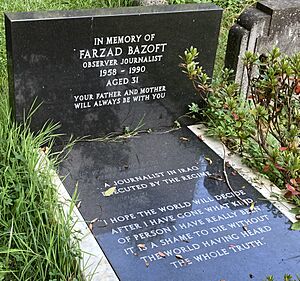Farzad Bazoft facts for kids
Quick facts for kids
Farzad Bazoft
|
|
|---|---|
| Born | 22 May 1958 Pahlavi Iran |
| Died | 15 March 1990 (aged 31) Baghdad, Ba'athist Iraq |
| Resting place | Highgate Cemetery, London |
| Occupation | Journalist |
| Nationality | Iranian |
| Period | c. 1980s–1990 |
| Subject | Middle East |
Farzad Bazoft (Persian: فرزاد بازفت; 22 May 1958 – 15 March 1990) was a journalist from Iran. He moved to the United Kingdom when he was a teenager in the mid-1970s. He worked as a reporter for a newspaper called The Observer. In 1990, Iraqi officials arrested him. He was accused of spying for Israel while working in Iraq. Farzad Bazoft was found guilty and sadly executed.
Contents
Farzad Bazoft's Life and Career
Farzad Bazoft moved to the United Kingdom in 1975 when he was 16 years old. After finishing his education, he became a freelance journalist. This means he wrote articles for different news groups instead of working for just one. He often wrote about the Middle East and the Iran–Iraq War. His articles appeared in places like The Observer newspaper and the BBC.
In 1989, the Iraqi government invited Farzad Bazoft and other journalists to Iraq. They were there to report on elections happening in Kurdistan. Before he left, Bazoft heard about a big explosion. It happened on September 19, 1989, at a military place called al-Iskandaria. This place was about 50 kilometers (31 miles) south of Baghdad. The loud explosion was heard even in Baghdad.
Even though Saddam Hussein, the leader of Iraq, wanted to keep the explosion a secret, rumors spread. People said the accident happened in a rocket factory. They believed many Egyptian engineers who were helping Iraq develop secret missiles had died.
Investigating the Explosion
Farzad Bazoft thought this could be a very important news story, called a scoop. He went to a town called al-Hilla to find out more details. He reportedly investigated with permission from Iraqi officials. The editor of The Observer, Donald Trelford, said that Bazoft was not a spy. He was just a reporter trying to get a story. He even told the Iraqi government where he wanted to go. This showed he was acting like a reporter, not a spy.
Other Western reporters were also interested in the story. However, a camera crew from Independent Television News was stopped by Iraqi officials before they could reach the factory. Farzad Bazoft managed to get there. He was driven by a British nurse named Daphne Parish. Bazoft also asked military people in Baghdad hotels and casinos what they knew. Hotel security then reported him to the Iraqi Intelligence Service.
Arrest and Trial
Farzad Bazoft was arrested at Baghdad International Airport in September 1989. He was waiting for his flight back to London. In his luggage, he had 34 photos of the al-Hilla area and some soil from near the factory.
He was held for six weeks in the Abu Ghraib prison. After being held under difficult conditions, Bazoft was shown on TV on November 1. He was made to confess that he was an Israeli agent. Daphne Parish, the nurse who drove him, was also arrested by Iraqi officials. Before their trial, President Saddam Hussein wrote to the British prime minister, Margaret Thatcher. He promised her that Bazoft and Parish would have a fair trial.
Farzad Bazoft's trial lasted only one day and was held in secret. There was no clear proof that he was guilty. Despite this, he was found guilty and sentenced to death on March 10, 1990. Daphne Parish was sentenced to 15 years in prison. However, she was released on July 16, 1990, after the president of Zambia, Kenneth Kaunda, asked for her release.
Many people around the world asked for Farzad Bazoft to be spared. But these requests had no effect. He was not allowed to appeal his conviction or sentence. He was executed by hanging at 6:30 AM on March 15, 1990.
What Happened Next
Farzad Bazoft's body was sent back to his family in the United Kingdom in a simple wooden box. Documents found after the 2003 invasion of Iraq showed that Saddam Hussein himself wanted Bazoft's execution to happen before Ramadan. Ramadan began on March 16 that year. This was to stop the British government from trying to save him.
Right after the execution, Britain called back its ambassador from Iraq. They also canceled all visits by government ministers. Bazoft's story made many people in Western countries very angry. It also made Saddam Hussein's government more isolated from the rest of the world. A few months later, on August 2, 1990, Iraq invaded Kuwait. This event started the first Gulf War. During that war, a tank from the UK's 7th Armoured Brigade was named Bazoft's Revenge.
In 2003, The Observer newspaper found Kadem Askar. He was the Iraqi intelligence colonel who first questioned Bazoft. He admitted that he knew Bazoft was innocent. But he said he could not go against Saddam Hussein's orders to have him found guilty and executed. Taped meetings from Hussein's government, found during the 2003 invasion, also confirm that Hussein himself ordered Bazoft's execution.
Papers released in 2017 from 1990 showed that the British government at the time decided not to take strong action against Iraq. They were worried it might hurt British trade with Iraq. Norman Lamont, a government official in 1990, told The Observer that Bazoft had an Iranian passport, which was seen as important. Farzad Bazoft was allowed to live in Britain permanently.


